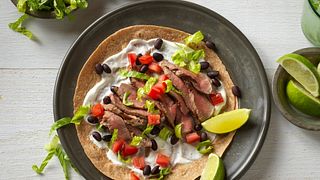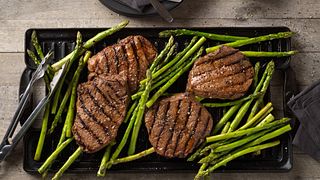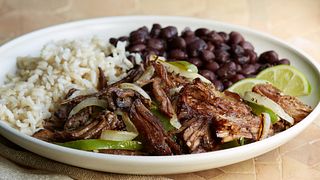GROUND BEEF PERFORMANCE: SALES TRENDS BY LEANNESS, FORM, AND PRIMAL
Figure 1. Retail Ground Beef Sales from 2020 – 20221.
Not only have ground beef sales seen an increase, but consumers have been purchasing ground beef to be used at later dates. Over 80% of consumers claimed to have at least 1 meal worth of ground beef in storage at home2. Roughly a third of consumers reportedly keep at least 1 – 2 meals worth of ground beef products in storage at home and a quarter of consumers claimed to keep between 3 – 4 meals worth of ground beef in storage at home2. For comparison, only 37% of respondents claimed to have at least one meal worth of a meat alternative in storage2.
Satisfaction levels with ground beef purchases remain high, with over 90% of consumers claiming to be satisfied with their ground beef eating experiences at home, and close to 90% claiming to be satisfied with the eating experience in a restaurant3. In addition to being satisfied with purchasing ground beef online, 20% of respondents indicated that they would be purchasing more ground beef than they did in 2021, while 61% claimed their ground beef purchases would remain the same as 20212. In an age of unprecedented price increases, consumers still find enough value in ground beef products to not substitute them out of their diets.
The fresh ground beef category is comprised of various ground beef forms available for purchase at retail, namely chubs, pre-formed patties, and random weight trays. Out of these popular forms, consumers can select if they prefer ground beef from specific beef primals (such as the chuck, round, or the loin). Figure 2 shows these popular ground beef forms as a percentage of ground beef sales by value and volume. Of these various forms, ground beef trays are the most popular, having sold over $9.6 billion dollars’ worth, or 87% of the total fresh ground beef sales in terms of value and over 2.1 billion pounds (89%) of sales in terms of volume so far in 20224. Pre-formed patties make up 12.4% of sold ground beef value, totaling $1.4 billion, and 10.7% of sold volume totaling 251 million pounds so far in 20224. Ground chub and other non-specified forms make up the smallest market share of the three major forms, with 0.2% of value sold, totaling $19.9 million and 0.2% of volume sold, totaling 3.9 million pounds so far in 20224.
Figure 2. Market Share of Major Ground Beef Forms4.
In terms of lean-to-fat ratio, the most popular ground beef products contain between 11-20% fat (80-89% lean)5. Ground beef products that contained 11-20% fat occupied 44% of ground beef sales by value, with a total of $4.8 billion sold so far in 20225. In terms of pounds sold, ground beef containing 11-20% fat accounted for 1.05 billion pounds, 45% of all ground beef sales by volume so far in 20225. Fresh ground beef products that contain 10% or less fat (90% or greater leanness), have sold approximately 325 million pounds (14% of the ground beef market by volume) worth $1.87 billion (17% of the ground beef market by value)5. Another popular option at retail are ground beef products that contain between 20-29% fat (70-79% lean), having sold approximately 458 million pounds (19% of the ground beef market by volume)5. Ground beef products that either claim to be lower than 70% lean or do not specify the leanness have sold around 515 million pounds (22% of the ground beef market by volume) worth an estimated $2.7 billion (25% of the ground beef by value)5. Figure 3 breaks down the ground beef market by leanness in terms of value and volume. These market shares have remained stable over the past few years, with 80-89% lean ground beef showing signs of slightly increasing market share over the past few years.
Figure 3. Market Share of Ground Beef by Leanness5.
Consumers can also select their preferred ground beef product according to the production claim label, such as grassfed, antibiotic/hormone free, organic, and all-natural ingredients. The largest of these claims is antibiotic free ground beef, which occupies roughly 5% of the total ground beef market, worth an estimated $557 million and accounting for roughly 78 million pounds6. Ground beef products labeled with grass fed claims currently occupy 4% of the total ground beef sales, worth an estimated $441 million6. In terms of pounds, an estimated 3% of ground beef pounds sold has grass fed production claims. Hormone free ground beef and organic ground beef round out the major production claims with 3.9% and 2.9% of ground beef value market share, respectively6. While these claims are only a fraction of the market, demand for production transparency appears to be growing, as ground beef sales with these production labels appears to have grown between the same timeframe of 2021 and 20226. For example, 60 million pounds of grass-fed ground beef were sold between January and November 2021, which is 2.8 million less pounds than have been sold so far in 20226.
While most ground beef products are unspecified, consumers can select from primal specific products, the most popular of which is the chuck, round, or sirloin. As shown by Figure 4, ground beef from the chuck remains the most popular of the specified ground beef cuts in terms of value and volume. Throughout 2022, over 475 million pounds of chuck-based ground beef have sold at retail, worth around $2.2 billion dollars7. Ground chuck currently occupies roughly 20% of all ground beef sold and has sold 386 million more pounds than round based ground beef, the second most popular primal based ground beef product7. Ground round and ground sirloin products have sold around 179 million pounds combined so far in 2022, occupying roughly 2% of the total ground beef market7.
Figure 4. Market Share of Ground Beef by Primal7.
Ground beef is a versatile, cost effective, and in demand beef product, in part due to the custom feel that ground beef offers. Whether shoppers are looking for a primal specific product, certain leanness percentage, or form, ground beef is well apt to cater to a multitude of lifestyles and preferences. This versatility helps explain why ground beef is consistently one of the best-selling beef products year-over-year. As consumer preferences continue to shift, ground beef will be sure to continue adapting to meet these needs.
Sources:
- NielsonIQ, Discover, Ground Beef Sales, YTD 44 Weeks Ending 11/05/2022. Analyzed by National Cattlemen’s Beef Association, on behalf of The Beef Checkoff.
- 2022 State of the Consumer Survey, Directions Research. Summarized and Analyzed by National Cattlemen’s Beef Association, on behalf of The Beef Checkoff. August 2022.
- Consumer Beef Tracker, Directions Research. Summarized and Analyzed by National Cattlemen’s Beef Association. January – October 2022.
- NielsonIQ Discover, Ground Beef Sales by Segment, YTD 44 Weeks Ending 11/05/2022, YTD Year Ago 44 Weeks Ending 11/06/2021. Analyzed by National Cattlemen’s Beef Association, on behalf of The Beef Checkoff.
- NielsonIQ, Discover, Ground Beef Sales by Leanness, YTD 44 Weeks Ending 11/05/2022. Analyzed by National Cattlemen’s Beef Association, on behalf of The Beef Checkoff.
- NielsonIQ, Discover, Ground Beef Sales by Production Claim, YTD 44 Weeks Ending 11/05/2022. Analyzed by National Cattlemen’s Beef Association, on behalf of The Beef Checkoff.
- NielsonIQ, Discover, Ground Beef Sales by Primal, YTD 44 Weeks Ending 11/05/2022. Analyzed by National Cattlemen’s Beef Association, on behalf of The Beef Checkoff.






